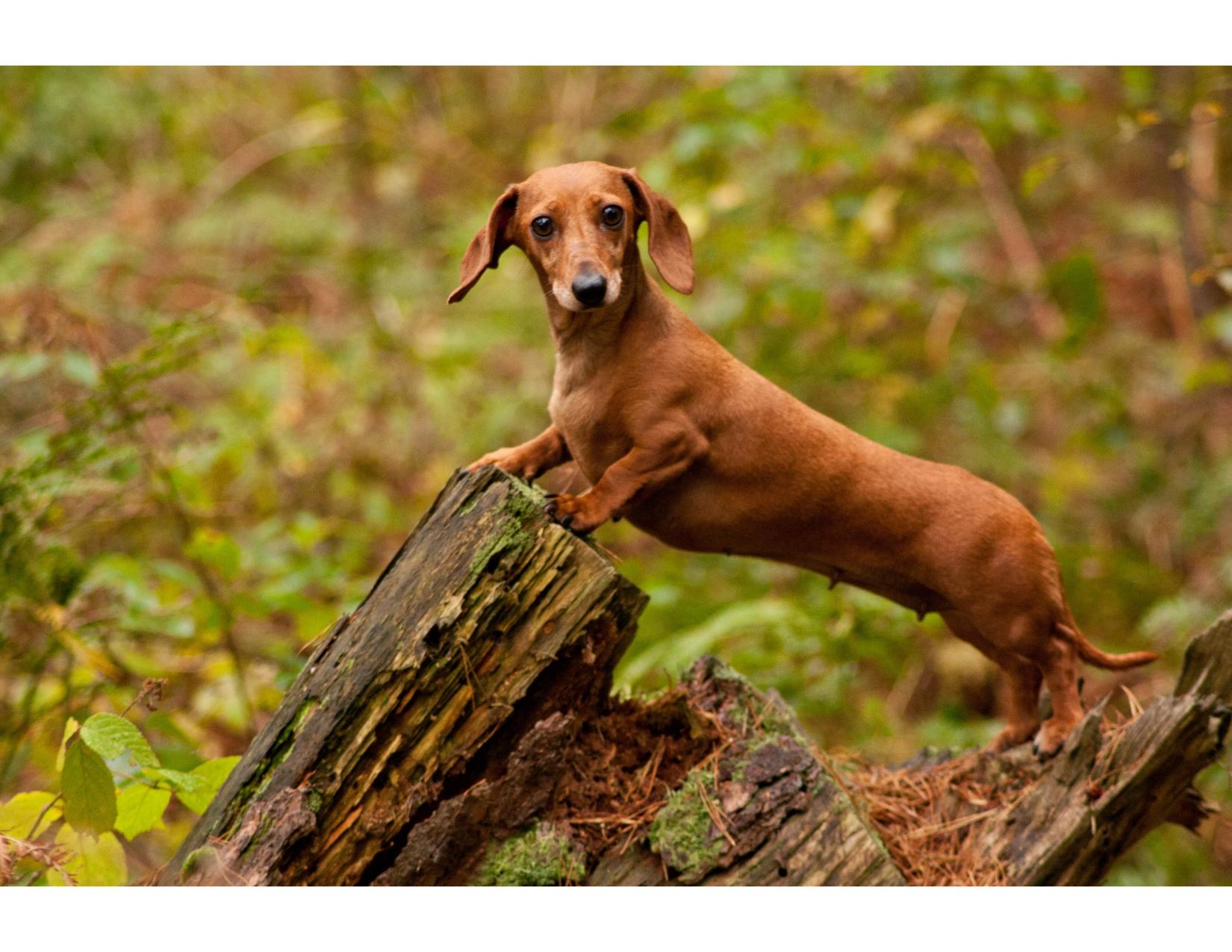DACHSHUND
| Group: | Hound |
|---|---|
| Size: | Small |
| Temperament: | Amiable, Inquisitive, and Silly |
| Height: | 7–9 Inches (male), 7–9 Inches (female) |
| Weight: | 6–14 kg (male), 6–14 kg (female) |
| Life Expectancy: | 12-15 years |
| Origin: | Germany |
| Coat Length: | Short / Medium |
| Coat Type: | Smooth |
| Color: | Black & Cream Black & Tan Blue & Tan Chocolate & Tan Cream Red Wheaten Wild Boar Blue & Cream Fawn(Isabella) & Tan Fawn(Isabella) & Cream Chocolate & Cream |
About
Despite their small size, Dachshunds require a lot of physical activity and mental challenge to keep up their happy and affectionate disposition. Being independent thinkers, they frequently disobey orders when hunting for prey. At unexpected visitors, dachshunds will bark in defense, but they get along well with older kids. The Dachshund is unquestionably an icon of purebred dogdom with his distinctive long-backed body, short legs, and big personality.
Nutrition
Extreme caution must be taken to prevent a Dachshund from gaining weight. This is done for the dog's general health as well as to prevent strain on its long back, which could result in slipped or ruptured (herniated) discs. Ignore the beseeching eyes and only feed your dog the amount recommended by the manufacturer of the premium dog food you have chosen. Give table scraps very rarely, if ever, and steer clear of cooked bones and foods with a lot of fat. Keep food out of the Dachshund's reach at all times because his nose can get him into trouble.
Ideal Meal Breakdown
Protein
29
Fat
17
Carbohydrates
46
Others
8
Exercise
There is a common misconception among owners that Dachshunds simply need to run about the home to get exercise.. However, they do require regular exercise in order to maintain their fitness and develop powerful back muscles. Two moderately long walks per day should be sufficient. Never let your Dachshund run up and down stairs or jump on or off of furniture to prevent injuries. Dachshunds don't do well as outdoor dogs because they prefer to be with their owners because they are such social creatures.
Grooming
Dachshunds have a low to nonexistent body odour, are moderate shedders, and are generally clean. The three coat types are smooth, long, and wirehaired and each require different levels of grooming. The only maintenance required for a smooth-coated Dachshund to look sharp is a quick wipe down with a towel or hound glove. Depending on the coat's thickness, longhaired Dachshunds might need to be brushed more frequently. The Wirehaired coat can be hand-stripped or plucked several times a year to maintain its best appearance, but aside from that, it is simple to maintain in between groomings with occasional trimming of the beard and eyebrows and once or twice a week brushing or combing. Each month, all Dachshunds should have their nails clipped.
Training
Dachshunds can be difficult to train because they are very intelligent but also independent and frequently stubborn. They thrive under positive, incentive-based training and enjoy both giving and receiving affection. Due to their sensitivity, they will not respond well to strict orders or punishment. The key is to be persistent and patient. Dachshunds have a strong prey drive and an excellent sense of smell. They may not always pay attention to you if they are preoccupied with something more interesting because they were bred to maintain concentration and follow a trail without getting sidetracked.
Health
The Dachshund is typically a healthy breed, and with the right care, he can expect to live 12 to 16 years as long as he follows a healthy diet and gets enough exercise to keep his muscles in good condition. Maintaining the Dachshund's weight in check and constantly supervising his activities will help prevent disc damage to his long, slender back. If their ears aren't kept clean, Dachshunds are susceptible to ear infections like the majority of dogs with drop ears.
History
The Dachshund was created to eagerly dig his way into a badger den and eliminate its inhabitant. The long, low body of the Dachshund was ideal for the gritty underground work. The intelligence, bravery, tenacity, and strength that characterise the modern Dachshund were first bred into his ancient ancestors to best prepare them for facing a deadly foe. The small dog's unexpectedly loud, hound-like bark also harkens back to his working days: It made it possible for the Dachshund's human hunting partner above ground to mark where his dog was digging down. The breed naturally has a short, smooth coat, but through selective breeding, long coats for cold climates and wire coats for work in brier patches were also produced. Dachshunds were bred in a range of sizes to work on various types of quarry. Breed experts claim that packs of Dachshunds were frequently used to hunt wild boar. The process of standardising the breed in terms of size, coat type, and colour varieties was well under way by the late 1800s.
